 Serbia is a curious country from the point of view of the folk costume. Serbian traditional clothing is diverse and beautiful. There is no single national outfit iconic for the whole country. Many various ethnic groups live in Serbia; therefore, their clothing traditions get entwined. It is really interesting to observe the regional features of folk attires. All of the costumes typical for different areas of Serbia are charming.
Serbia is a curious country from the point of view of the folk costume. Serbian traditional clothing is diverse and beautiful. There is no single national outfit iconic for the whole country. Many various ethnic groups live in Serbia; therefore, their clothing traditions get entwined. It is really interesting to observe the regional features of folk attires. All of the costumes typical for different areas of Serbia are charming.
The photos and info for captions were kindly provided by Milan P. Stepanov
The main cloths used to make a folk clothing traditionally are linen, hemp, cotton, and wool. Of course, the fabric used to be homemade until the 20th century. Nowadays, few traditional pieces of clothes are sewn from the homemade materials, most of the fabrics are factory-made. But even in the old times, people sometimes used factory-made fabrics (silk, brocade, velour, lace, etc.), especially for the festive outfits.
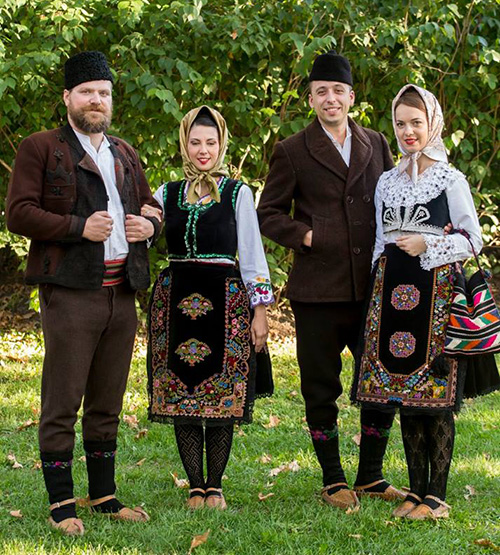
Serbian people in the folk costumes from Žagubica (village in the Braničevo District of the eastern Serbia). The photo was taken at the Festival of folk clothing "Biserna grana", Futog, Novi Sad, Serbia
Different parts of Serbia during their history got under the influence of the neighboring countries. It is an ordinary situation for the border countries to share some clothing features and peculiarities. That’s why the clothing traditions of Serbia is so diverse. You can easily find some features of Germany, Ottoman Turkey, Hungary, Italy, or Austria in the folk costumes of various regions of Serbia. Historically, Serbian folk costumes are a mix of Balkan, medieval Serbian, Turkish-Oriental, Byzantine, and Slavonic features. The folk dress is not just an outfit – it is a sign of one’s origin and a way of keeping the ancient traditions. The costumes have a special and important meaning in the ethnically mixed communities.
Let’s talk in detail about Serbian traditional men’s and women’s costumes. Of course, we will only outline the general features of the outfits typical for this country. If we wrote here in detail about every regional attire, there would be tons of information. But you’ll be able to learn more about the regional costumes of Serbia in our next articles.
Male traditional dress of Serbia
The male folk outfit consists of an embroidered shirt, trousers, a vest, outerwear, a belt, a headdress, knitted socks, and shoes.
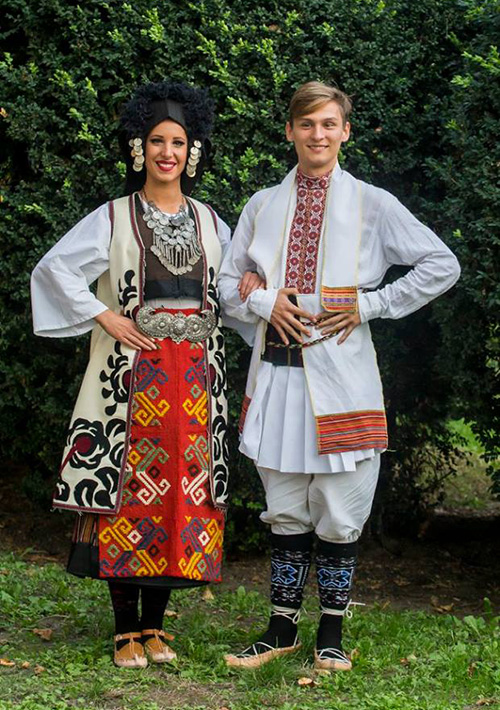
Serbian folk costumes. The female outfit is from Knjaževac (town in the Zaječar District of the eastern Serbia). It is a costume of a married woman. Her headdress is called “krpa”. Under the krpa she has an interesting hairdo called “trvelj” (the hair is braided, 2 braids are twisted around the ears and embellished with coins). The male outfit is from Kumanovo (city in the Republic of Macedonia). Part of Macedonia is called “Old Serbia” because this territory used to belong to Serbia once. The photo was taken at the Festival of folk clothing "Biserna grana", Futog, Novi Sad, Serbia
In general, men’s folk costumes in Serbia are rather unified (while female outfits are more diverse from region to region).
Male chemise or shirt has a cut similar to the women’s one. Mostly, the shirt is about thigh-length but can be much longer. In some regions, it is tucked into the trousers, in other areas, the chemise is left loose and belted. The shirt itself is made from white (in some parts of Serbia, black or brown) woolen cloth and decorated with embroidery designs.
The trousers were different for different regions of the country. In some areas, males wore narrow trousers, in others, wide baggy pants. The traditional breeches worn by Serbian men are called “caksire”. They are comparatively tight and made from woolen cloth. These breeches are considered to be of old Balkan origins. The caksire can be belted with a fabric sash called “trabolos” (colorful silk belt) or a leather belt with pockets called “silav”.

Embroidered male traditional clothes and beautiful flask. It is an attire of a man who invites people to the wedding in Serbia. The costume is from Gradiška (town in northwestern Bosnia and Herzegovina, part of the Republika Srpska entity), the area is called “Lijevče polje”. The photo was taken at the Festival of folk clothing "Biserna grana", Futog, Novi Sad, Serbia
There are many variations of a headdress of Serbian men. There is a cap with thin brims (made from a waterproof cloth and covered with silk), a lamb fleece hat, a woolen hat, a fez, etc. In winter, sometimes a cotton cloth or woolen scarf is wrapped around the hat for warmth. In the end of the 19th century, Serbian men started to wear a headdress called “Šajkača cap” (it is pronounced as “shajkacha). Today, this hat is worn mostly in the rural areas and often by elderly men. But in the 16th-19th centuries, it was the main headdress of a military uniform. The troops guarding the Austrian Empire against the Ottoman Turks used such caps. In the 18th century, civil people also began to wear Šajkača caps. This headdress is usually made from soft black, dark blue, or gray homemade cloth. It has a V-shaped top similar to the bottom of an upturned boat. As a part of the folk dress, Šajkača cap is monochrome, without any symbols, but in a wartime, soldiers used cockades, monograms, and similar symbols on their caps.
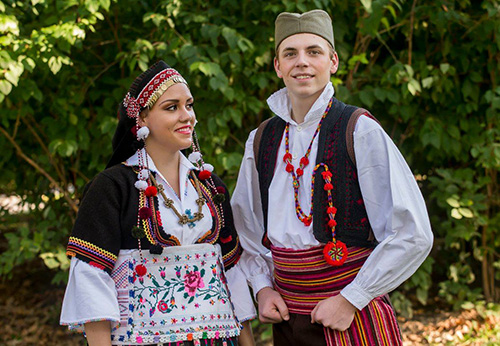
Husband and wife in the traditional clothing from Gnjilane (city in eastern Kosovo). The photo was taken at the Festival of folk clothing "Biserna grana", Futog, Novi Sad, Serbia
The obligatory and very bright piece of Serbian traditional costume is woolen hand-knitted socks. Usually, they are dark (black, blue, or red) with colorful patterns. The high (up to the knee) socks are both warm and stylish. And these socks became a symbol of Serbia, as well as the shoes – leather moccasins with upturned toes. The shoes are called “opanci”. They’re used not in all of the regions of Serbia, but opanci are considered to be the famous symbol of the area (Serbia, Croatia, Bulgaria, Macedonia, etc.).
The winter clothing for men in Serbia is made from fur, wool, and other heavy fabrics. The clothes items are vests, jackets, cloaks, and coats. Festive outerwear is decorated with plenty of bright embroidery and applique on white (most often) background. These pieces are very pretty and colorful.
Female traditional dress of Serbia
The female folk attire consists of a chemise (long shirt), a skirt, a bodice, a belt, an apron, an outerwear, a headdress, knitted socks, and shoes.
The chemise is a long shirt with some or lots of embroidery. Usually, the shirts are embroidered on the sleeves, around the neck, and on the hem. The sleeves of the chemise used in Serbia are peculiar: they are gathered just above the elbow (by the way, the sleeve can be long or elbow-length) and often tied with a red ribbon. This cut of a shirt is the most common.
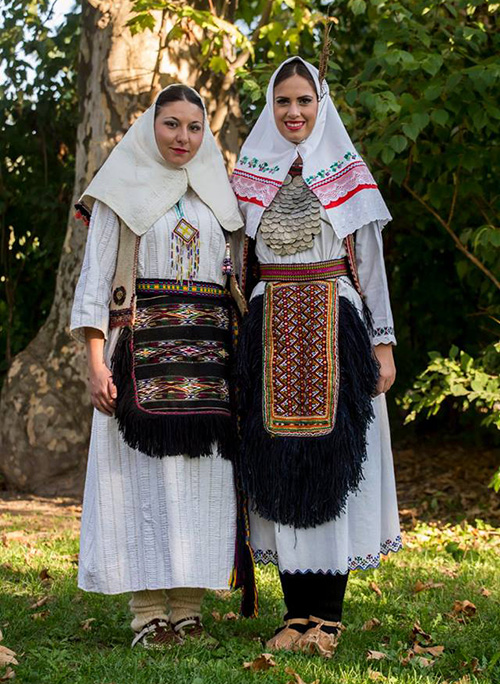
Serbian female folk clothing from Imljani (village in Bosnia and Herzegovina, Entity of Republika Srpska) and Kozara area (mountain in western Bosnia and Herzegovina). The photo was taken at the Festival of folk clothing "Biserna grana", Futog, Novi Sad, Serbia
There are many various kinds of a vest or bodice. They are called “grudniak”, “pamuklija”, “djudica”, “zubun”, etc.; the most popular and widespread is “jelek”. Each of the mentioned vests has a unique cut and design. For example, jelek is short, hooked or laced at the front, with a lot of embellishments. The color is usually black or red. Young girls use a jelek with a low neckline (it serves as a bustier and emphasizes the curvy shapes) while older women wear a jelek with much higher neckline (more like a vest than a bustier).
Skirts also are different, according to the region of usage. There can be woven skirts of various lengths, a two-piece skirt that consists of two aprons (one is worn at the back and the other at the front), and other variants. The color of the skirt is often plain, with a decorated hem or adorned with embroidery. Very popular is a striped or checkered skirt. Sometimes a woven wrap-around skirt is used, and its front corners are tucked into the waistband at the back. Such a way of wearing a skirt is very comfy when the woman needs to move a lot – the skirt doesn’t restrict movements.
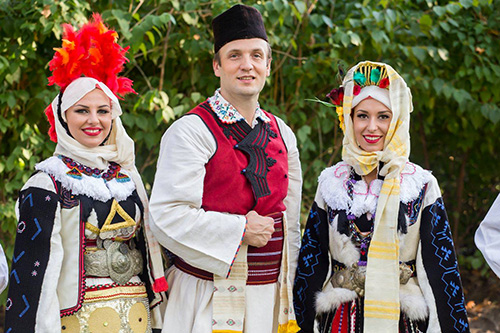
Man and two married women in Serbian folk outfits from Skopska Crna Gora (Black Mountain of Skopje) near Skopje (capital of Macedonia). The photo was taken at the Festival of folk clothing "Biserna grana", Futog, Novi Sad, Serbia
A woven belt with various ornamentation serves as a sash.
The apron is usually either white or black (though, other colors are allowed as well), decorated with a lot of floral embroidery. Sometimes almost the whole apron is covered with embroidery patterns.
The traditional headdresses in Serbia are often called “oglavja”. Usually, they are scarves and caps. The headgear is also richly decorated with embroidery. Young girls braid their hair and use small caps with flat top or scarves. Married women often use kerchiefs. A headdress called “trvelji” is also popular among the married females. It consists of two plaits made by weaving woolen strands together. These plaits are woven into the hair and fold by the ears.

Man and woman in Serbian traditional clothing from Skopska Crna Gora (Black Mountain of Skopje) near Skopje (capital of Macedonia). The photo was taken at the Festival of folk clothing "Biserna grana", Futog, Novi Sad, Serbia
The obligatory and very bright piece of Serbian traditional costume is woolen hand-knitted socks. Usually, they are dark (black, blue, or red) with colorful patterns. The high (up to the knee) socks are both warm and stylish. And these socks became a symbol of Serbia, as well as the shoes – leather moccasins with upturned toes. The shoes are called “opanci”. They’re used not in all of the regions of Serbia, but opanci are considered to be the famous symbol of the area (Serbia, Croatia, Bulgaria, Macedonia, etc.).
The winter clothing for women is made from fur, wool, and other heavy fabrics. The clothes items are vests, jackets, cloaks, and coats. Their color often is white with crimson, dark-colored, or multicolored embroidery and applications. Female outerwear is very bright and richly embellished, but male winter clothing can be surprisingly more colorful and festive.
Decorations of Serbian folk costumes
Serbians are very skillful craftsmen – or, to be precise, craftswomen because almost all of the outfits traditionally were made and decorated by women – in embroidering. It is the main technique of decorating the folk clothes. Serbia has a very strong tradition of embroidering. It is one of the main traditional crafts of this country. Serbian men and women use long embroidered shirts as a main part of the folk costume. The shirts have richly embroidered sleeves, collar, breast, and/or hem. Wool, cotton and sterling threads were used to create great patterns on linen, hemp, or cotton.
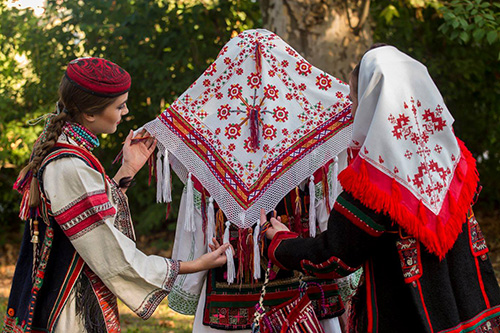
Serbian female folk costumes from Bukovica region (it is Croatia today). The women on the photo are from Bukovica, but they live in Stanišić village now (northern part of Serbia). They are the participants of a folk dance band “Izvor”. The woman at the left is wearing the outfit of an unmarried girl, the female in the center has a traditional wedding dress of a bride on, and the woman at the right is wearing the attire of a married woman (bride’s mother or groom’s mother). As you can see, a married female traditionally uses a kerchief when an unmarried girl wears her hair braided and sometimes covered with ornate headdresses. All three of the costumes are richly embroidered with the traditional patterns. The photo was taken at the Festival of folk clothing "Biserna grana", Futog, Novi Sad, Serbia
The patterns are usually geometric or floral. Serbs use multiple colors to make their embroidery designs. The red color is among the most widespread (in some areas, only different hues of red are used). Golden and silver threads are also very popular, especially for the velvet background.
Another technique widely used by Serbian craftswomen to adorn the outfits is applique. It can be found rather often, especially on the outerwear. Appliques of black and dark-blue woolen yarn are among the most common. Also, appliques done in fabric and leather are used.
Serbian traditional clothes can be also embellished with braiding, tassels, yarn pom-poms, and other decorative elements.

Man and woman from Sarajevo (capital of Bosnia and Herzegovina) wearing the traditional Serbian outfits. Similar costumes are used by Serbs who live near Sarajevo, Skopje, and in Romanija area (mountain and geographical region in eastern Bosnia and Herzegovina). The photo was taken at the Festival of folk clothing "Biserna grana", Futog, Novi Sad, Serbia



totally agree ! I'd really, really like to see some traditional Russian clothes please